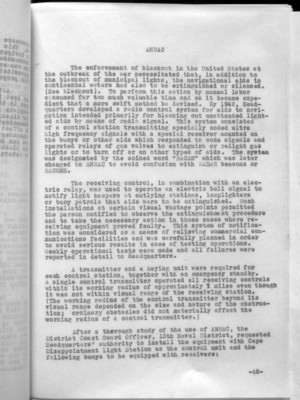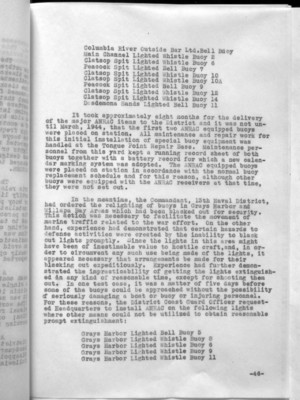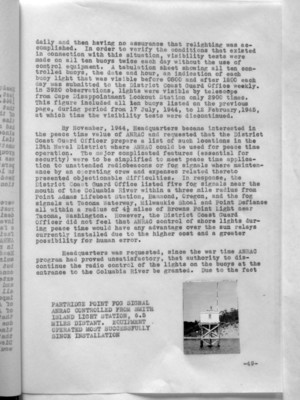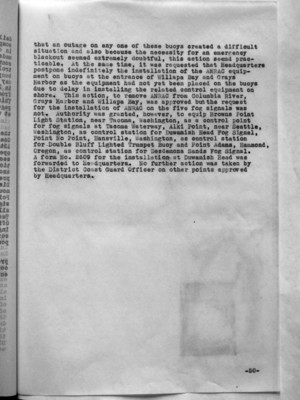Pages That Mention District Coast Guard Officer
Coast Guard District narrative histories 1945
63
The District Liaison Officer suggested a system for the control of coastal lighthouses as employed by the Canadian Navy to be initiated in a similar way for U. S. Lighthouses. The Canadian Plan consisted of a broadcast three times a day at regular hours to all lighthouse keepers along the Coast. The system was divided into lettered plans; i.e., Plan "A" meant to keep lights burning bright, "B", submarine scare and all lights must be extinguished, etc. The District Coast Guard Officer did not accept this recommendation as the District plan then in use provided for extinguishment or relighting of any or all lights on a few minutes advance notice. The District system had the following advantages:
(a) It provided more positive communication and means of checking receipt of instruction.
(b) It provided greater security and more flexibility of instruction.
(c) It did not depend on any outside agency.
Proposals for dimming coastal lights were di(s)approved because of the unlighted gaps between lights which would have existed when the lights were dimmed.
A test blackout was held in March, 1942, for all Lifeboat and Light Stations. As a result of this test, it was decided that Seattle Radio Station, Westport, would, in the future, broadcast a whistle blast preceding the instructions for blackout. Upon hearing the whistle over the air, all personnel standing radio watches were instructed to copy the message which followed and notify their Commanding Officers. Because of the possibility that telephone communications between Lifeboat and Light Stations might not be available at the time a blackout was ordered, all Light Stations which were radio-equipped were ordered to maintain a radio watch during the entire time the light was burning.
Revisions of the Blackout Plan^1 were made periodically to keep each section of the District cognizant of any changes in that particular area. After each revision, holders of Blackout Plans were ordered to destroy copies of previous Plans by burning. In 1945, a complete coverage of state railroad bridges, covering the area as far east as the Cascades, was completed and included in the Plan. It was advised by the Aids to Navigation Officer that similar blackout regulations be continues during peace time so that any confusion, in the event of a similar emergency, might be eliminated. It was further recommended that tests of the Plan be made occasionally be effecting a total blackout as there was no
-43-
65
The enforcement of blackout in the United States at the outbreak of the war necessitated that, in addition to the blackout of municipal lights, the navigational aids in continental waters had also to be extinguished or silenced. (See blackout). To perform this action by manual labor consumed far too much valuable time and so it became expedient that a more swift method be devised. By 1942, Headquarters developed a radio control system for aids to navigation intended primarily for blacking out unattended lighted aids by means of radio signal. This system consisted of a control station transmitting specially coded ultra high frequency signals with a special receiver mounted on the buoys or other aids which responded to code signals and operated relays of gas valves to extinguish or relight gas lights or to turn off or on other types of aids. The system was designated by the coined word "RACAN" which was later changed to ANRAC to avoid confusion with RADAR beacons or RACONS.
The receiving control, in combination with an electric relay, was used to operate an electric bell signal to notify light keepers at outlying stations, lamplighters or buoy patrols that aids were to be extinguished. Such installations at certain visual vantage points permitted the person notified to observe the extinguishment procedure and to take the necessary action in those cases where receiving equipment proved faulty. This system of notification was considered as a means of relieving commercial communications facilities and was carefully planned in order to avoid serious results in case of testing operations. Weekly operational tests were made and all failures were reported in detail to Headquarters.
A transmitter and a keying unit were required for each control station, together with an emergency standby. A single control transmitter operated all receiving controls within its working radius of approximately 7 miles even though it was not within visual range of the receiving station. (The working radius of the control transmitter beyond its visual range depended on the size and nature of the obstruction; ordinary obstacles did not materially affect the working radius of a control transmitter.)
After a thorough study of the use of ANRAC, the District Coast Guard Officer, 13th Naval District, requested Headquarters' authority to install the equipment with Cape Disappointment Light Station as the control unit and the following buoys to be equipped with receivers:
-45-
66
Columbia River Outside Bar Ltd.Bell Buoy Main Channel Lighted Whistle Buoy 2 Clatsop Spit Lighted Whistle Buoy 6 Peacock Spit Lighted Bell Buoy 7 Clatsop Spit Lighted Whistle Buoy 10 Clatsop Spit Lighted Whistle Buoy 10A Peacock Spit Lighted Bell Buoy 9 Clatsop Spit Lighted Whistle Buoy 12 Clatsop Spit Lighted Whistle Buoy 14 Desdemona Sands Lighted Bell Buoy 11
It took approximately eight months for the delivery of the major ANRAC items to the District and it was not until March, 1944, that the first two ANRAC equipped buoys were placed on station. All maintenance and repair work for this initial installation of special buoy equipment was handled at the Tongue Point Repair Base. Maintenance personnel from this yard kept a running record sheet of both buoys together with a battery record for which a new calendar marking system was adopted. The ANRAC equipped buoys were placed on station in accordance with the normal buoy replacement schedule and for this reason, although other buoys were equipped with the ANRAC receivers at that time, they were not set out.
In the meantime, the Commandant, 13th Naval District, had ordered the relighting of buoys in Grays Harbor and Willapa Bay Areas which had been blacked out for security. This action was necessary to facilitate the movement of marine traffic related to the war effort. On the other hand, experience had demonstrated that certain hazards to defense activities were created by the inability to black out lights promptly. Since the lights in this area might have been of inestimable value to hostile craft, and, in order to circumvent any such use being made of the lights, it appeared necessary that arrangements be made for their blacking out expeditiously. Experience had further demonstrated the impracticability of getting the lights extinguished in any kind of reasonable time, except for shooting them out. In one test case, it was a matter of five days before some of the buoys could be approached without the possibility of seriously damaging a boat or buoy or injuring personnel. For these reasons, the District Coast Guard Officer requested Headquarters to install ANRAC on the following lights where other means could not be utilized to obtain reasonable prompt extinguishment:
Grays Harbor Lighted Bell Buoy 5 Grays Harbor Lighted Whistle Buoy 8 Grays Harbor Lighted Whistle Buoy 6 Grays Harbor Lighted Whistle Buoy 9 Grays Harbor Lighted Whistle Buoy 11
-46-
69
daily and then having no assurance that relighting was accomplished. In order to verify the conditions that existed in connection with this situation, visibility tests were made on all ten buoys twice each day without the use of control equipment. A tabulation sheet showing all ten controlled buoys, the date and hour, an indication of each buoy light that was visible before 0800 and after 1200 each day was submitted to the District Coast Guard Office weekly. In 3920 observations, lights were visible by telescope from Cape Disappointment Lookout Station only 2900 times. This figure included all ten buoys listed on the previous page, during period from 17 July, 1944, to 12 February, 1945, at which time the visibility tests were discontinued.
By November, 1944, Headquarters became interested in the peace time value of ANRAC and requested that the District Coast Guard Officer prepare a list of such locations in the 13th Naval District where ANRAC could be used for peace time operation. The major complicated features (essential for security) were to be simplified to meet peace time application to unattended radiobeacons or fog signals where maintenance by an operating crew and expenses related thereto presented objectionable difficulties. In response, the District Coast Guard Office listed five fog signals near the mouth of the Columbia River within a three mile radius from Point Adams Lifeboat Station, Hammond, Oregon, and the fog signals at Tacoma Waterway, Milwaukie Shoal and Point Defiance all within a radius of 4 1/2 miles of Browns Point Light near Tacoma, Washington. However, the District Coast Guard Officer did not feel that ANRAC control of shore lights during peace time would have any advantage over the sun relays currently installed due to the higher cost and a greater possibility for human error.
Headquarters was requested, since the war time ANRAC program had proved unsatisfactory, that authority to discontinue the radio control of the lights on the buoys at the entrance to the Columbia River be granted. Due to the fact
(image)
PARTRIDGE POINT FOG SIGNAL ANRAC CONTROLLED FROM SMITH ISLAND LIGHT STATION, 6.5 MILES DISTANT. EQUIPMENT OPERATED MOST SUCCESSFULLY SINCE INSTALLATION
-49-
70
that an outage on any one of these buoys created a difficult situation and also because the necessity for an emergency blackout seemed extremely doubtful, this action seemed practicable. At the same time, it was requested that Headquarters postpone indefinitely the installation of the ANRAC equipment on buoys at the entrance of Willapa Bay and Grays Harbor as the equipment had not yet been placed on the buoys due to delay in installing the related control equipment on shore. This action, to remove ANRAC from Columbia River, Grays Harbor and Willapa Bay, was approved but the request for the installation of ANRAC on the five fog signals was not. Authority was granted, however, to equip Browns Point Light Station, newar Tacoma, Washington, as a control point for fog signals at Tacoma Waterway, Alki Point, near Seattle, Washington, as control station for Duwamish Head Fog Signal, Point No Point, Hansville, Washington, as control station for Double Bluff Lighted Trumpet Buoy and Point Adams, Hammond, Oregon, as control station for Desdemona Sands Fog Signal. A form No. 2609 for the installation at Duwamish Head was forwarded to Headquarters. No further action was taken by the District Coast Guard Officer on other points approved by Headquarters.
-50-




